Brawls, Booze and True Believers: The Saints’ Wild First Season

It’s late June in the NFL. Minicamps have broken, and teams have dispersed for some R&R before training camps open late next month. So it’s time for something different: 1967 Week at The MMQB. Join us as we look at what the game, the players and the culture of professional football were like a half-century ago. First up, the debut of the New Orleans Saints.
John Mecom looked around at the chaos that engulfed him, at the 50-odd players on the Yankee Stadium field, their fists flying wildly, at the fans pouring down from the stands, legs lurching over the railing to join the ruckus, and the owner of the New Orleans Saints thought to himself, Damn, I probably shouldn’t be out here.
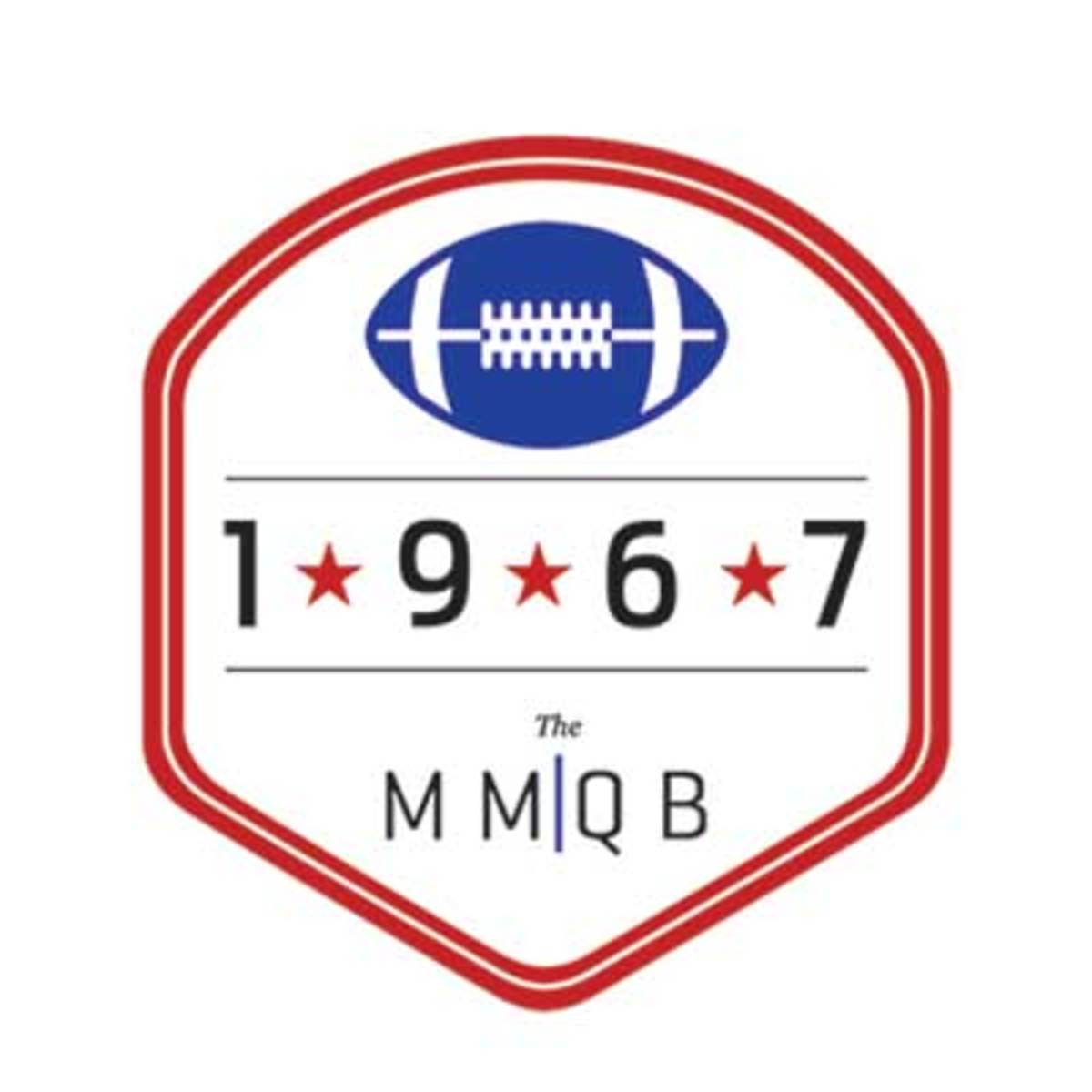
It was fun, for a couple of minutes. Mecom had rushed to the aid of the felled Doug Atkins, who had three Giants players whaling on him. But now Atkins was on his feet, and Mecom couldn’t quite figure out why the 39-year-old defensive end kept tossing his helmet to him. So Mecom just kept throwing it back, like they were playing a game of catch in the middle of a war zone.
“He was trying to tell me to put the helmet on to protect myself,” Mecom, 77, says now. “But I didn’t understand that.”
Had Mecom just wanted to be a fan—had he wanted to sit in the stands—he would have bought a ticket for six dollars. But he didn’t. In December of the previous year he’d paid the $8.5 million expansion fee for the newly minted NFL team in New Orleans. At 26, he was younger than most of the players on his team, and he watched every game from field level. And so when linebacker Steve Stonebreaker had come to the sideline, with the clock winding down in the fourth quarter, and told everyone to gird themselves for a fight that would begin right after the final whistle, goddamn if he wasn’t going to run out onto the field with rest of the guys and hit somebody.
These were the 1967 New Orleans Saints in a snapshot. This was the NFL before the league became a massive monolith, before professional football had become the biggest sports business in America. This was a simpler time, a more romantic time, a bygone era in which a team owner could find himself in the middle of a massive brawl during a televised game and not be headline news.
“Before the league got so cleaned up,” as Mecom says.
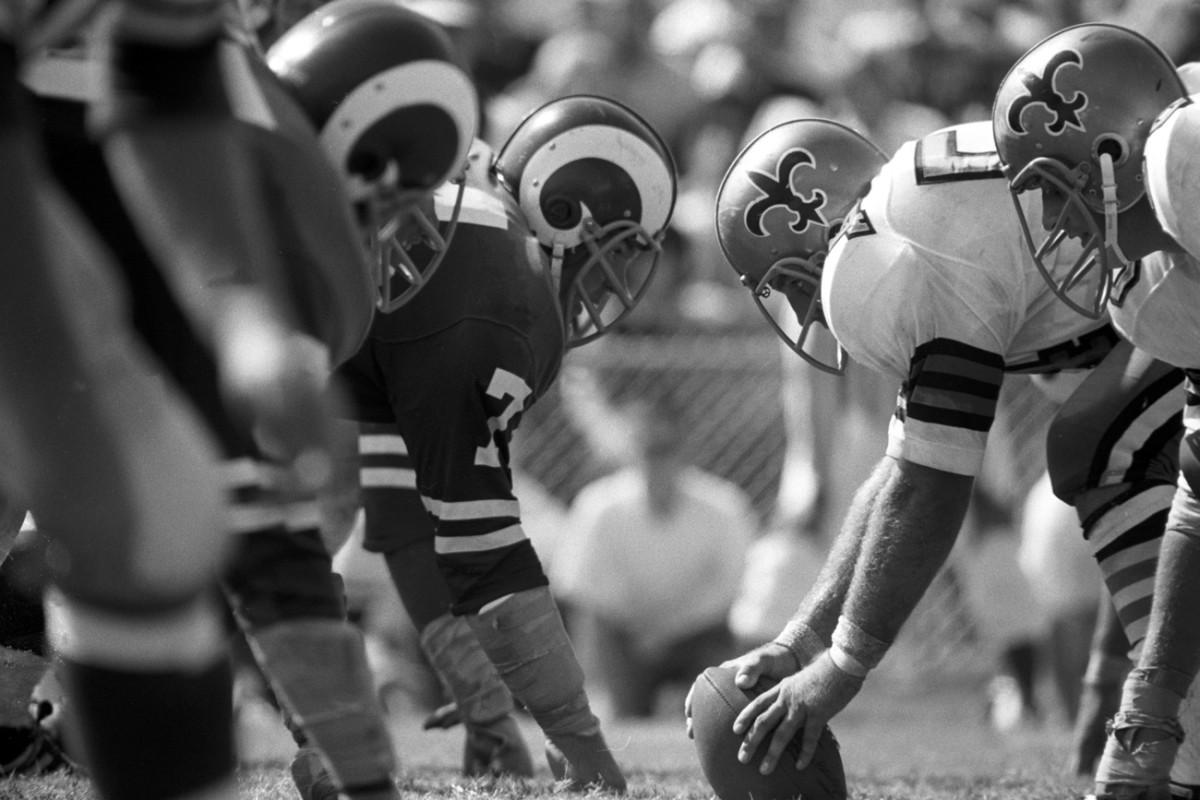
The 1967 Saints were a hapless but wildly entertaining expansion team, mired in various forms of dysfunction; a cartoonishly tough team filled with characters straight out of central casting—a linebacker named Stonebreaker—who reveled in bacchanalian exploits and topped it all with flourishes of showmanship. In other words, the Saints were a perfect match for New Orleans.
This was before Drew Brees, before the Super Bowl title, before a stadium sponsorship from Mercedes-Benz. Before even the ’Aints era, when the fans would put paper bags over their heads to signify their dissatisfaction yet would still show up religiously. Still, 50 years on from that inaugural season, as the team has morphed from lovable losers to perennial playoff contender, some of the ethos of the franchise has remained unchanged.
“At that age I thought I could handle anything,” says Mecom. “But nothing prepares you for professional football.”
It all started when Mecom, the 6’3”, 225-pound mountain of a man known as Little John, brought the NFL to the Big Easy. Quickly the Saints and the city of New Orleans forged an inextricable, inexplicable bond. Not that it was ever particularly easy.
Since he was 15, Little John had been an integral part of his father’s oil empire, an ever-expanding conglomerate that generated a family fortune in excess of $200 million by the mid-’60s. As a teenager he had brokered deals in countries such as Lebanon, Israel, Yemen and Afghanistan. He owned 15 cars—Ferraris, a Lotus, a Scarab, a Lola, several De Tomaso racers, Corvettes, Mustangs, an Amphicar that drove across water—and 10 airplanes. On the family ranch near Houston he housed a menagerie of 75 animals, brought over from Africa and elsewhere, in a 5,000-acre refuge—lions and zebras and llamas and the like. By the time he was 25, his Mecom Racing Team had become one of the most successful auto racing units in the country.
“At that age, and with the success I had, I thought I could handle anything,” he says. “But nothing prepares you for professional football.”
* * *
The names would come in over the Teleprinter every day, a long sheet of paper unspooling out of the machine and folding onto itself, listing all of the players available on the waiver wire. They were the castoffs from around the NFL, cut from their respective teams before the season. And the Saints wanted them all.
It was the summer of 1967, and the team was holding its first-ever training camp on the campus of Cal Western in San Diego, high up on a hill overlooking the Pacific. Like all new franchises, the Saints were building their roster with unproven rookies and unwanted veterans, players other NFL teams hadn’t protected in the expansion draft. But they still needed more—if not talent, then at least bodies. So as summer wore on the Saints kept picking up players; their training camp was like the NFL’s Ellis Island, open to anyone and everyone
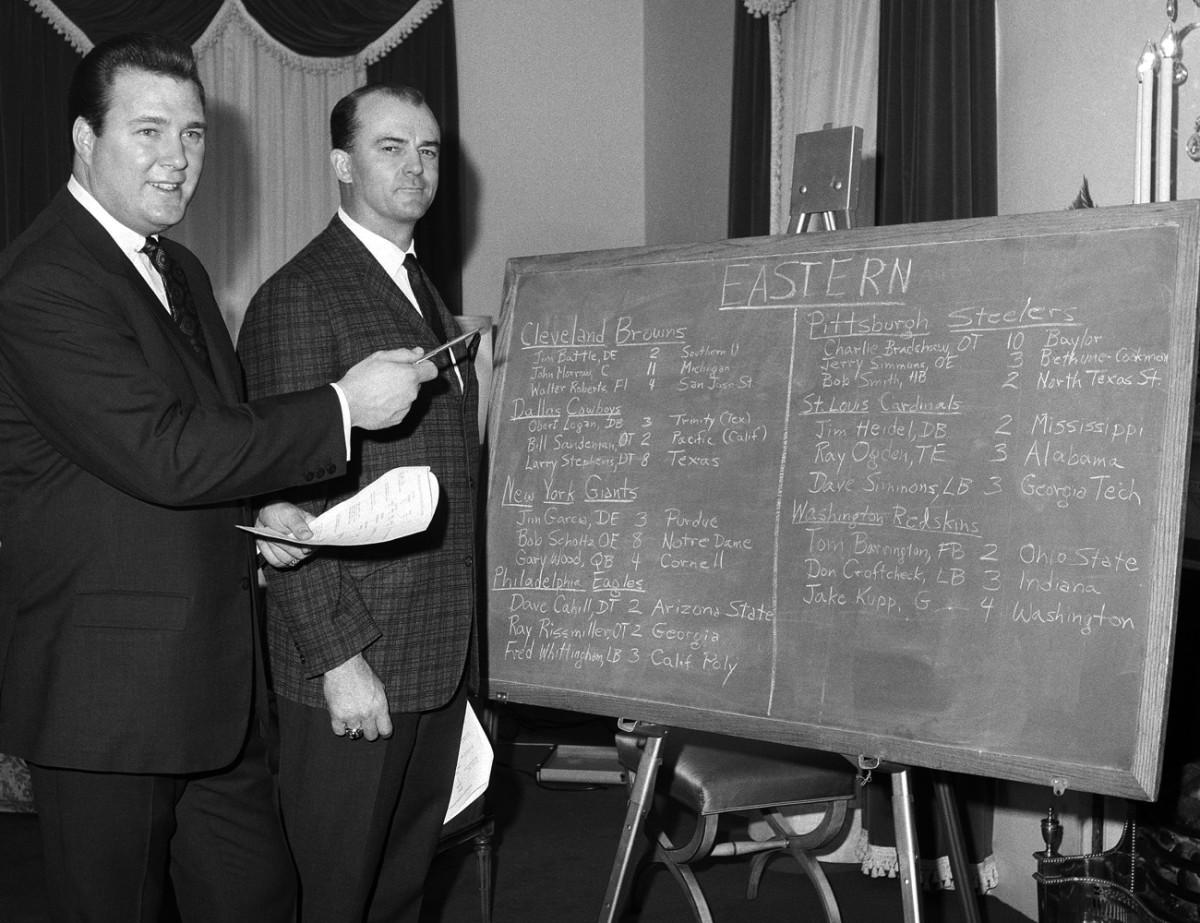
Coach Tom Fears, with an ethos forged by years spent under Vince Lombardi, was running brutal two-a-days—but at least the weather was temperate and the view was nice. Still, on the first day of camp two rookies packed up and left, not even waiting for their $10 paycheck. “We haven’t got time for the guys who don’t want to hit,” Fears said then. “The guys who went home would have left in a little while anyway.”
An estimated 300 to 400 players cycled in and out of that first Saints camp. And it was Bill Becknell’s job to pick them all up at the airport.
At 18 years old, Becknell was the team’s first ball boy—not a bad way to spend the summer before freshman year of college. So it was that he found himself driving 20 minutes from the campus to the airport and back again every day as hopefuls flew in to San Diego. He’d drive those same players back to the airport, often the following day—except now they’d be in a worse mood, unceremoniously cut, wondering why they had wasted their damn time coming all the way out here, anyway.
“I always called it like a troop movement in the service, where guys come in and then they leave,” quarterback Billy Kilmer says. “They’d come for breakfast, and then I’d never see them again.”
The players would churn through so frequently that they wouldn’t be given jerseys with names or numbers. Instead, their names would be written on a piece of tape and stuck to the side of their helmets. Which made life particularly complicated for Charlie Shepherd, who’d come over from the Falcons with Fears to be the team’s first equipment manager. Shepherd had no office that season; he worked out of the laundry room at a nearby Hilton.
“Lord have mercy,” Shepherd says. “It was a disaster that year.”
But on the field, the Saints looked … good? They won five of their six (yes, the NFL played six) preseason games, and sure, they used their presumed starters for pretty much the entirety of those games, while opponents rested their top players. But still, they were winning. No one had expected that. So as the regular season was set to begin, expectations were soaring—both within the team and among its burgeoning fan base.
* * *
Ask 84-year old Charles Breaux if he lived in New Orleans in 1967, if he still lives there now with his wife, Joan, and if he’s lived there his whole life, and he’ll drawl, “Of course,” with an unmistakable New Orleans twang. “Is there any other place to live?”
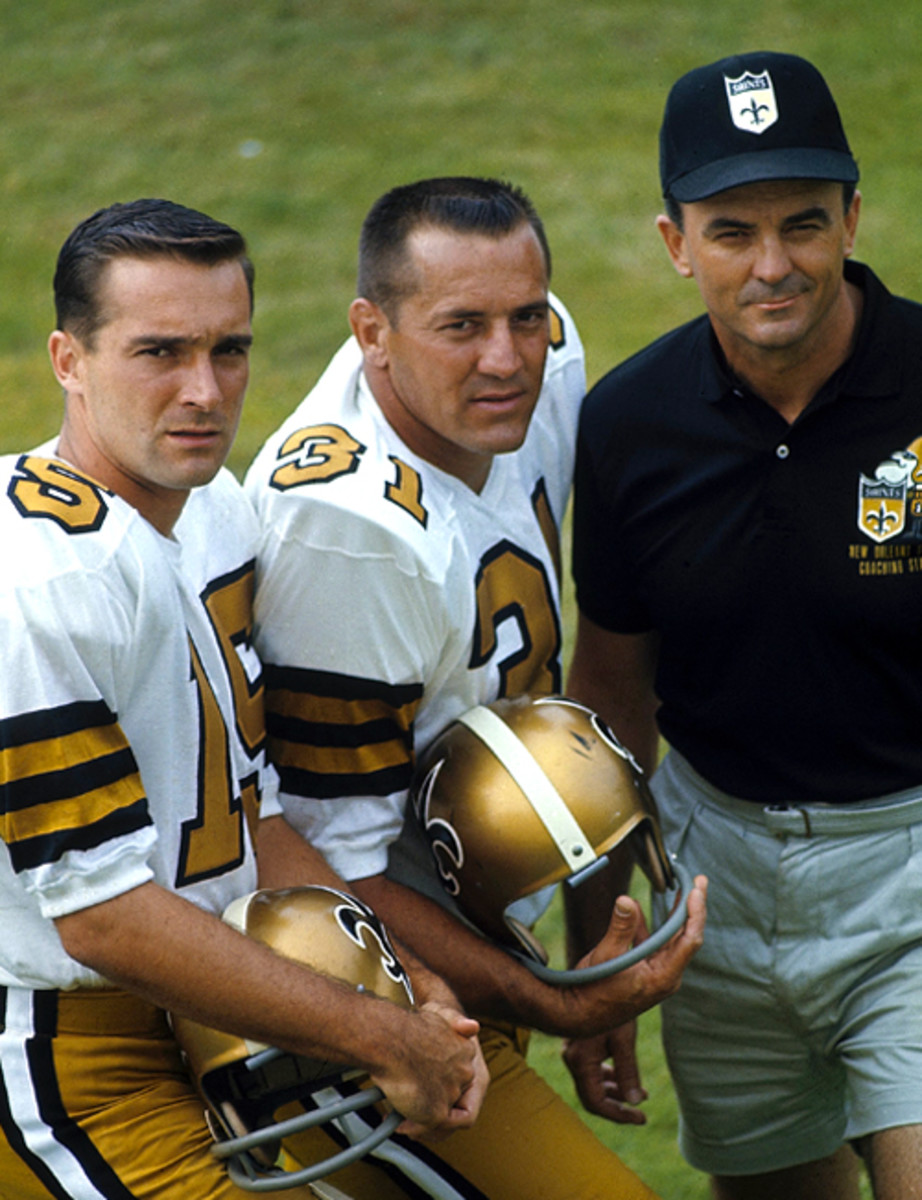
Charles, a retired chemical engineer, was 34 when the Saints came to town. He and Joan had six children and a shared passion for football. For years they had attended Tulane games, sitting in the faculty section because that’s where tickets were most readily available, wearing their finest clothes because, well, that’s just what you did in the faculty section. When the NFL brought preseason games (which were then played at neutral arenas) to Tulane Stadium in the early 1960s, Charles and Joan would be among those who filled the stands to watch two random professional football teams play.
“Then came this wonderful NFL team,” Charles says. “And it was our own.”
At first they’d buy tickets on a game-by-game basis, just the two of them—and they’d quickly learn that the Saints had no dress code; the faculty section this was not. A few seasons later they’d splurge on season tickets, six seats in the northwest endzone, so they could take their oldest children along with them. Seats for the kids cost one dollar. Sometimes they’d even buy extra tickets for other kids in the neighborhood, load them all up in their Volkswagen bus and haul the whole crew out to the games. They wanted to share the Saints gospel with anyone willing to be proselytized.
The first game was scheduled for September 17. Since all of the team’s exhibition games had been played away from home, when the 5-1 squad flew back to New Orleans a week before their season opener, 3,000 disciples were waiting to greet them at the airport at 7 in the morning. “We all figured we were going to the Super Bowl,” Joan says.
So of course Charles and Joan were among the nearly 83,000 in attendance at Tulane Stadium for that first-ever regular season game, against the Rams on September 17. It was 90 degrees at the time of kickoff that day, but a New Orleans 90—the air so humid and heavy that it was difficult to breathe. And when the Saints won the toss and elected to receive, and Bruce Gossett kicked the ball off into that thick Louisiana air, the Breauxs and the rest of the crowd rose to cheer. As the football descended, every eyeball in the place was fixed on the rookie who settled underneath it—a man who just moments ago had been praying that the ball would be kicked to anyone else.
* * *
John Gilliam wants to make it clear that there are three moments in his life he is most proud of. He repeats them all to make sure this is understood. “And don’t forget now,” he says, “my three greatest moments.”
The first one was when he was drafted into the NFL and was able to tell his mother that they’d made it. A single mom raising five kids in Greenwood, S.C, she’d sacrificed everything for him, and Gilliam says the best moment of his life was when he turned that dynamic around and could now help her. Gilliam hasn’t forgotten her words to him that day. The lord blessed me through you, she said, tears welling up in her eyes, and his too.
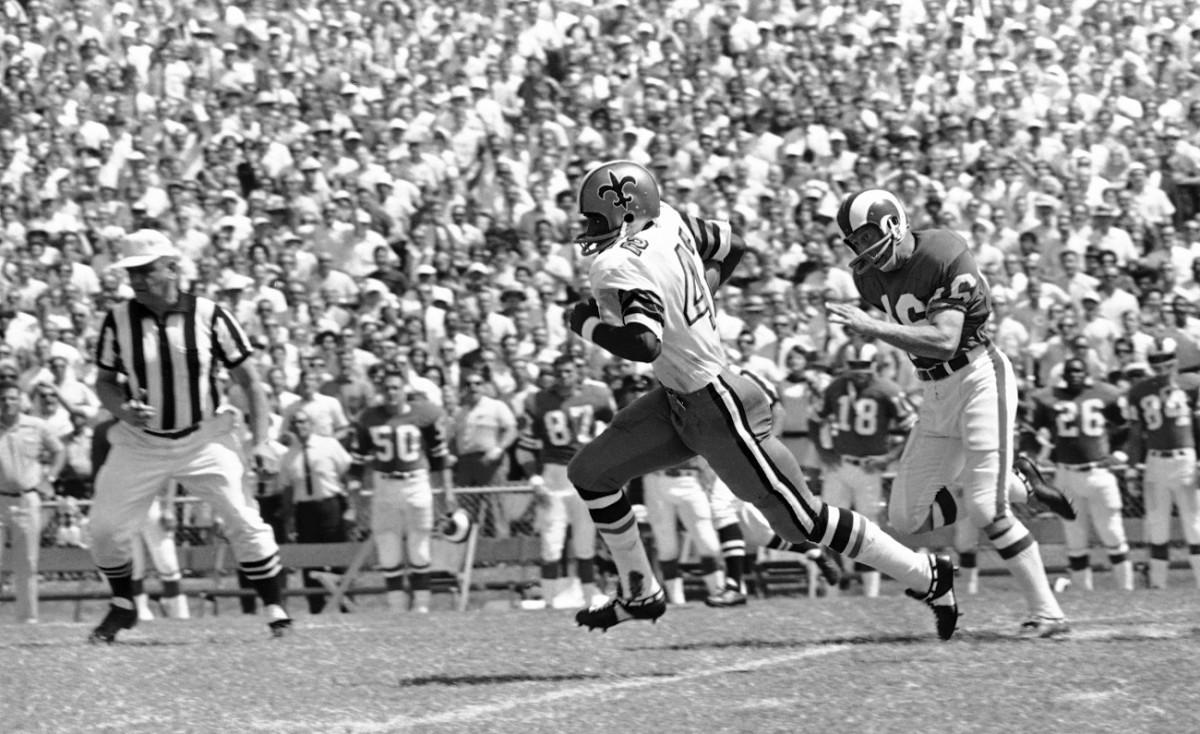
The second best moment of John Gilliam’s life was the day he was told he’d made the Saints, after that grueling three-month training camp. Despite being a second-round pick, Gilliam was convinced the team had been trying to cut him, so he’d volunteer for every drill and every unit, special teams included. He just wanted to play professional football; he didn’t much care about in what capacity. So whenever the coaches would ask if a player was interested in trying out something new, Gilliam was always the first to offer his services.
“They’d say, if you want to do this, raise your hand,” Gilliam says. “And so I raised my hand for everything.”
That’s how he ended up at the five-yard line at Tulane Stadium, awaiting the first ever kickoff in Saints franchise history— which begat the third greatest moment in John Gilliam’s life.
Sure, Gilliam was a collegiate track star; at South Carolina State he ran the 100-yard dash in 9.4 seconds, back when the world record was 9.1. (Alas, Bullet Bob Hayes was in his same conference, so Gilliam was always racing for second place.) But Gilliam had never played in front of a crowd larger than 20,000. Going into that first game, he was just happy he made the team. So how in the world did he find himself here, standing on the five-yard line, in front of 83,000 screaming New Orleans fans, thinking, Oh, lord please don’t let that guy kick that ball to me.
As the kickoff soared high in the air, it began to drift towards the middle of the field, into no-mans land, and so both he and veteran Flea Roberts began to settle underneath it. As they grew closer to one another, they both simultaneously called for it, and then they both simultaneously deferred and said that the other had it. They ended up nearly on top of one another, arms outstretched, as if they were fighting for a rebound.
At the last second Gilliam stepped in front, snagged the ball and took off up the field. At the 20-yard line he burst through a wedge of three defenders. At the 30 he shed a diving tackle that just clipped the back of his left foot. At the 40 he saw that he had a defender chasing him down from behind. By the 50 it was clear that he had burned that guy.
“Then when I got to about their 45, I saw the kicker had an angle on me,” Gilliam says. “But I just kept running. I knew he wasn’t going to catch me.”
Gilliam sprinted into the left corner of the end zone, and promptly flicked the ball into the stands in jubilation, where Joan and Charles Breaux sat, their finest duds now covered in Jack Daniels and 7 Up— the fans behind them had spilled their beverages all over their backs. Neither Joan nor Charles cared. The entire stadium had erupted; it felt like the entire city.
“At that point I said that I can never miss a game, ever,” Joan says. “It was ’til death do us part.”
“We would fight at the drop of a hat. We didn’t win many games, but we won the fights.”
The Saints lost that opening game, and then the next six. No matter—the city was hooked. The team had made a loud arrival, entering the league like only a team from New Orleans could. It would get no quieter.
Halftime shows at Tulane Stadium that year resembled Mardi Gras parades. They would have men in jet packs flying around the field just for the hell of it. They had actors reenact the Battle of New Orleans, wheeling cannons onto the 50-yard line and then setting them off—an event that was not replicated, as one worker blew a few fingers off that day. There were hang-gliders that flew into the stadium, and a hot air balloon that crashed into the stands. Members of the local media would race atop ostriches. After every game, the Charlie Saints Marching Club would parade through the city, tossing Mardi Gras beads and all.
“Sometimes the score wasn’t favorable,” Mecom says, “but the halftimes were the best in the league.”
And yes, there were also the fights.
* * *
They fought each other in training camp, 400 men literally battling for 40-odd roster spots. They fought the Chargers during a scrimmage, ending when linebacker Fred Whittingham—a former Gold Gloves champion—punched Hall of Fame coach Sid Gilman in the jaw. They scuffled with the Rams after the Gilliam return, and with just about every other team throughout the season. As the losses piled up, so did the tussles.
“We would fight at the drop of a hat,” defensive tackle Dave Rowe says. “We didn’t win many games, but we won the fights.”
No fight was bigger than that one with the Giants at Yankee Stadium on October 8. With the clock winding down and New Orleans trailing by a touchdown, desperately attempting to mount one last attack, Saints receiver Tom Hall caught a pass near the Giants sideline and was run out of bounds. He collided with New York center Greg Larson and went sprawling backwards, thudding to the ground.
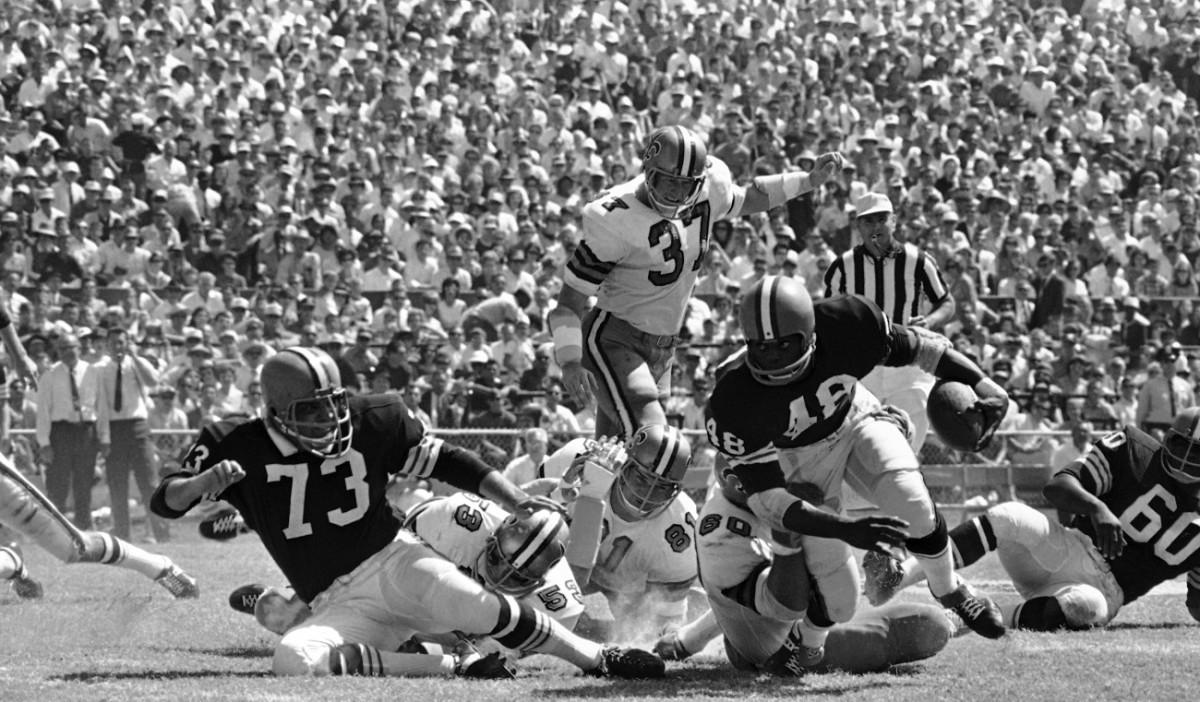
Looking back now, it is largely agreed that the contact was incidental, that Larson simply saw Hall careening toward him and at the last second threw his arms up in reaction. But standing on the opposite sideline, Steve Stonebreaker saw a play that he’d describe after the game as “worse than a cheap shot.”
So Stonebreaker ran across the field to notify Larson in no uncertain terms that he was coming for him after the game. Then he returned to the Saints sideline and relayed the plan to his own team.
“All of a sudden it’s 40 going against 40,” Rowe says, “and we are having a fight like you can’t believe.”
As Rowe flew across the field to join the ranks, he saw two Giants players restraining Atkins, both of his arms pinned back, while receiver Homer Jones was whacking away at him with his helmet. This is an accusation that, 50 years later, Jones does not deny—although he’s quick to point out it was the only fight he was in during his seven seasons in the NFL.
“Yeah, I pulled my helmet off and started swinging it,” Jones says, “but it was in retaliation. It was kind of a group thing.”
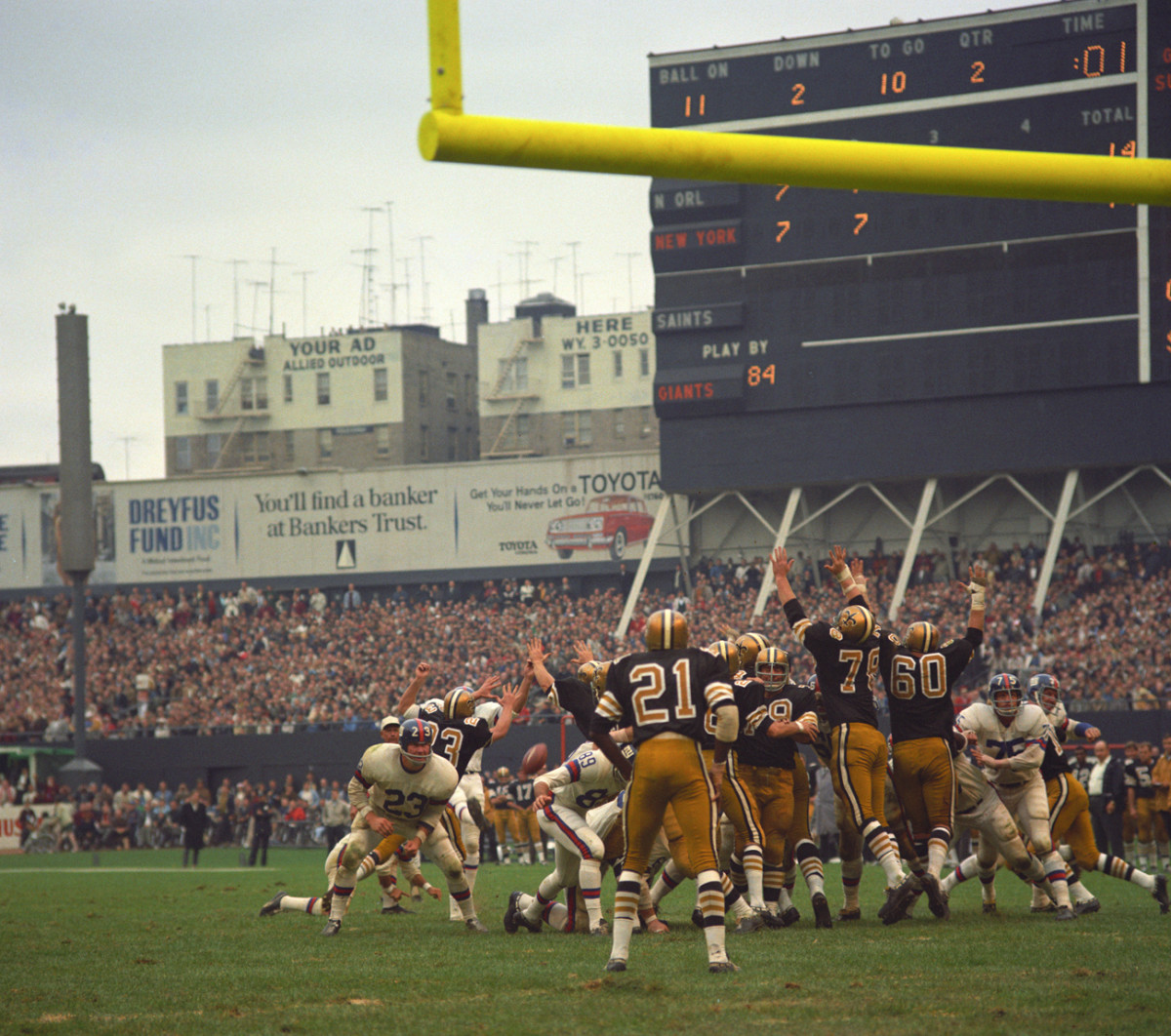
When Rowe saw his teammate being assailed, he went soaring in and speared them all, the entire group tumbling to the ground like a collapsed Jenga tower. Atkins was the first one to get back on his feet, and he proceeded to stomp on his tormentors.
“Like he was putting out a cigarette,” Rowe says.
This is about when Mecom found himself in the middle of the melee, about when the now-freed Atkins attempted to help the team’s owner out by tossing him his helmet. But Mecom didn’t have time to figure out that this was for his own protection; Giants receiver Freeman White was now charging right at him, swinging his own helmet in Mecom’s direction.
So the owner dodged and swung back. His right hook connected, dropping Freeman to the Yankee Stadium grass. Mecom would later learn that the punch had also broken his right hand—likely the first and last time an NFL owner earned a one-punch knockout over an NFL player.
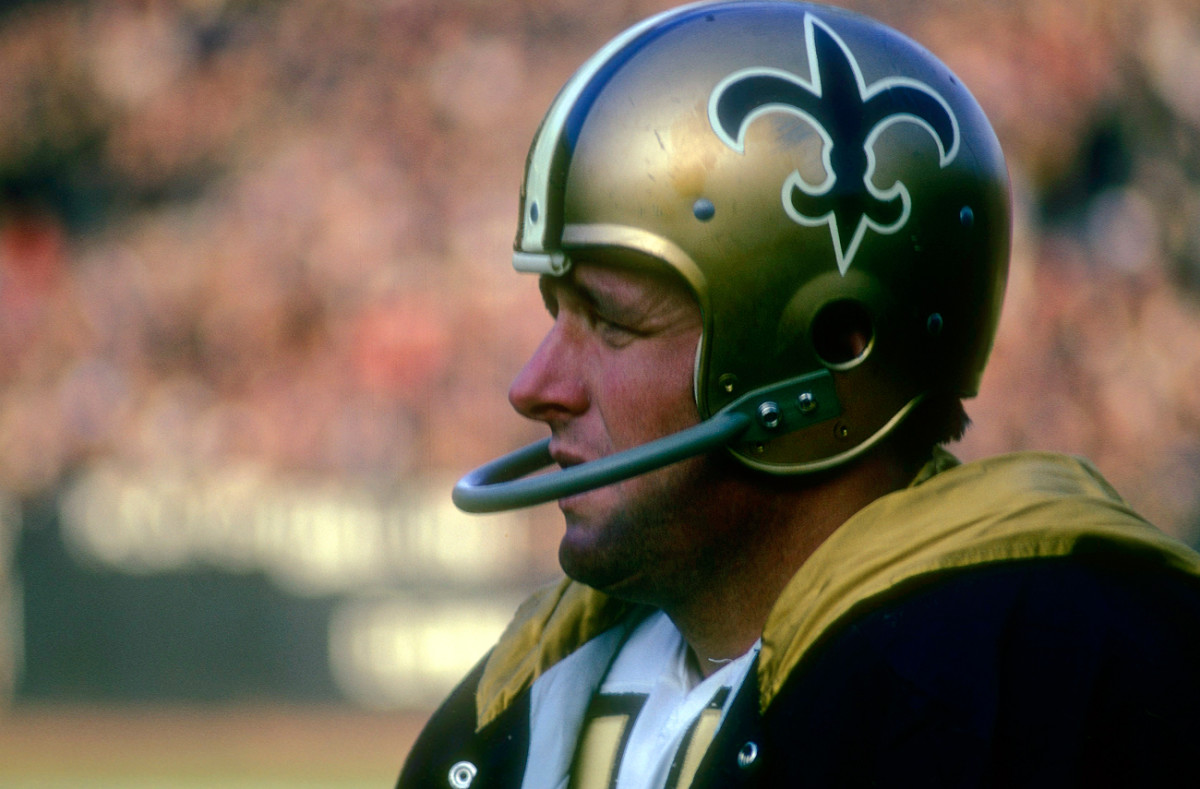
“It was unnecessary,” Mecom says, “but that was part of the magic of the NFL back then.”
Eventually the Saints players would look at the tableau unfolding around them, Giants fans climbing over the railing—just a short drop from the first row on the third-base side—and pouring onto the field in bunches. “And they weren’t coming to congratulate the Giants,” Rowe says. “They were coming after us. “
The team made it to the locker room without serious injury. The following week Mecom would find himself in commissioner Pete Rozelle’s office. The owner initially tried to deny his involvement but soon realized that television cameras had captured the whole thing. He’d be fined and reprimanded—nothing more than a slap on the wrist.
“Thank god it wasn’t today’s world,” Mecom says.
Back home in New Orleans, the Breauxs watched the brawl unfold on their television screen. They were proud of the team for their effort in the game, and even more so for their gallantry in the fight. So when the Saints flew back to New Orleans the following day, Charles and Joan were there on the tarmac with the Charlie Saints Marching Club— as they were every week after a road game—to welcome the heroes back home. The players exited the plane celebrating and smoking cigars, and when Stonebreaker walked into the crowd, he handed Joan one. Joan kept that cigar safe for 48 years, until Charles accidentally threw it out two years ago.
* * *
Fifty years later, their club is still meeting. At first they called it The Enforcers Club and draped a large banner in the south end zone of Tulane Stadium proclaiming that they were Stoney’s Sinners.
When Stonebreaker got fined for starting the melee—somewhere between $2,000 and $5,000; history has lost the exact amount—a small group of fans raised the money themselves and sent it to the team’s headquarters. Such is the connection between team and city. Although the NFL wouldn’t allow the money to cover the fine—the team built a handball court at the practice facility instead—Stonebreaker had turned into a local legend, those same fans forging a club in his honor.
“We had a rule in my family: No births, deaths or marriages during Saints season.”
“Steve Stonebreaker became our Enforcer,” Charles Breaux says. “And so that was the first name of our club.”
Eventually the organization would change its name to something more socially acceptable: The Touchdown Club of New Orleans. Its current president, Terry Rowe, says she moved to New Orleans 43 years ago “not for Mardi Gras, but for the Saints.” Every year the club sponsors a crawfish boil for Saints rookies, a Meet the Saints luncheon and an awards banquet. Members still gather at a restaurant in New Orleans every Tuesday, and with a Saints player as guest speaker each week.
Charles is a longtime member, officer and committee chair and now acts as an adviser to the club. Joan, for her part, hasn’t missed a Saints home game—ever. And that includes the games played in San Antonio and Baton Rouge the year Katrina hit. Charles sheepishly admits that he’s missed “a couple” games over five decades—but the only one that he can actively recall came when he was passing a kidney stone.
“We had a rule in my family: No births, deaths or marriages during Saints season,” Joan says. “And it was followed.”
No, the games weren’t always wins. Actually, they rarely were. It took the Saints more than 20 years to earn their first winning season and over 30 to get a playoff victory. Mecom is quick to admit that owning an NFL team was much more challenging than he realized at first, and sure he has regrets. He says he took advice from the wrong people and didn’t listen enough to the right ones (Art Rooney being chief among the latter).
“You do become, well, the Monday Morning Quarterback,” Mecom says. “I look back on it now and say I wish I woulda, coulda, shoulda. But I didn’t.”
He was simply too young to own an NFL team, he says. He sold the Saints for $72.5 to Tom Benson for $72.5 million in 1985 and believes he got out at the right time. He looks now at the vastly changed landscape of the league, at the billions of dollars in revenue, and remembers the days when the owners sat in school desks at the NFL’s Park Avenue headquarters, the days when you “had to raise your hand to go to the bathroom.”
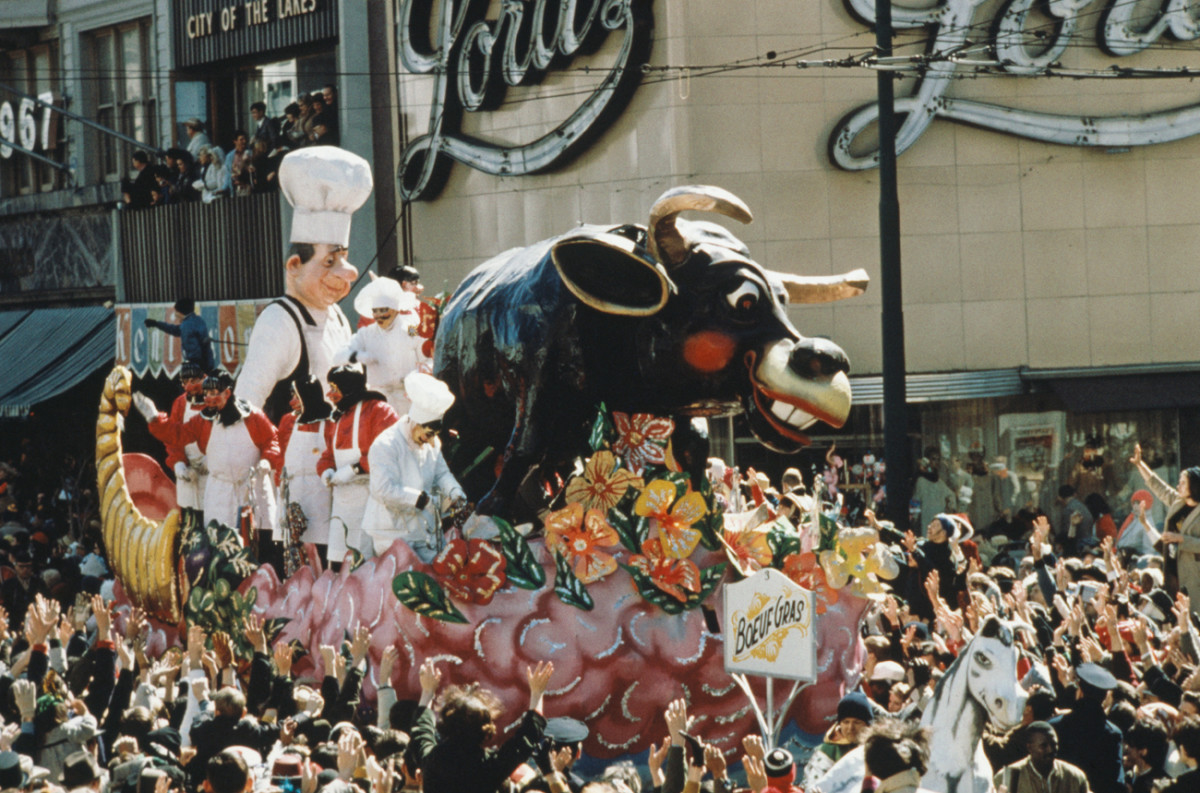
“Professional football became not the place for a romantic,” Mecom says. ‘It’s just a different world that I don’t think I could survive in.”
Still, Mecom says wistfully, it was a great experience being a part of the team for two decades, a great honor, even if he never considered himself the team’s true owner.
“I wasn’t the owner of the Saints—the people of New Orleans were,” he says. “It was their team, it was not mine.”
Question or comment? Email us at talkback@themmqb.com.
